Text
Welcome!
Hi! I’m Callum. I’m a third year student at the University of Portsmouth studying BSc (Hons) Television and Broadcasting. This blog will be filled up with various bits and pieces-from research to reflection on my personal development as a television professional. Feel free to have a look around!
As a third year Television and Broadcasting student at the University of Portsmouth, we run CCITV- our faculty’s professional television outfit. This blog centres around everything that happens in the making of a show that gets broadcast live every Friday on the channel. Throughout our University, we've got three studios- the Rotunda studio, the CCI studio and the Eldon Broadcast Hub (our new one!). The latter two are the ones that third year students use and it's great fun combining the use of studios for different shows.
Three different types shows regularly air live on CCITV. One of these is CCI Live, a programme made for the Creative and Cultural Industries faculty (which we call CCI) here at the University of Portsmouth. It features lots of different events and news, and targets a wide range audience as well as students and CCI staff. Secondly, we have Eye On Portsmouth, a show that targets not just the University of Portsmouth but also the public of Portsmouth. The programme marries the University and the city of Portsmouth, featuring local news and events within the Portsmouth area. Thirdly we have World On A Plate, a show that pushes creativity and celebrates countless cultures, giving people a snapshot of a new culture from anywhere in the world!
The shows all go live throughout the University, on ccichannel.port.ac.uk and we also go live on Portsmouth's Big Screen right in the city centre as pictured below!
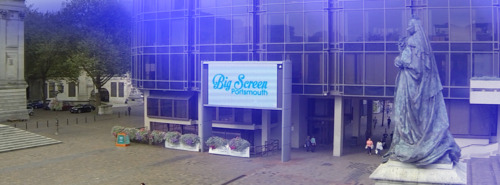
Above: Portsmouth's Big Screen, where CCITV programmes are broadcast every Friday at noon.
Expect technical chat such as information about television kit, how I’m using it with CCITV and the skills I have improved on and I have picked up on the way.
In the meanwhile, you are more than welcome to contact me however you please such as on my University e-mail which is [email protected] ,
or my regular e-mail which is: [email protected]
or connect with me on LinkedIn here: https://www.linkedin.com/profile/view?id=145746140&trk=nav_responsive_tab_profile.
Finally, I hope you enjoy reading what’s on here. Feedback, chat or advice is always welcomed, particularly if you’re working in the industry reading this blog.

Speak soon!
Callum O’Leary
3rd year (BSc Hons) Television and Broadcasting student.

0 notes
Text
Further Research: EQ usage for Sound Operation in a live environment.
In my last post on sound I talked about my interest in sound operation (here:I really love sound operating, as you’re a hugely important part of the show. Sometimes I think sound operators are quite undervalued in television, as much of the focus is on great visionary work. But if you’ve got no sound, you’ve got no show!
I’m now at a stage where I’m confident in working with multiple channels in live studio productions, but I thought to myself- how can I improve in this role still?
So I was looking my trusty Mackie 1604 VLZ3 mixer and I noticed I hadn’t used the EQ settings before, so I decided to experiment a little because I wanted to get the best out of their voices in today’s Eye On Portsmouth show. I did during the rehearsals rather than live because otherwise their voices would have been all over the place. We had a range of guests who had some really different voices. Today’s female presenter had a high pitched voice, but one of our guests had a much lower tone to his voice- it was incredibly low and quite bass-y so this gave me a chance to really experiment and even these out a little so it just sounded that bit better on broadcast.
So let’s break down EQ- it means equalization. It is essentially a filter, which can cut or boost different parts of sound within a system or show set up- in my case it’s the Mackie sound desk that allows me to do so. It adds that little bit of production value to a television show and it’s really worth knowing.
As mentioned, our female presenter had a high voice, so I cut this a little and added a low-pass filter to it, eliminating that squeak-like sound. Another guest had a low voice, it had quite a rumble, so I added some high pass filtering to his voice.
The problem with EQing is that you can only add so much filtering before it becomes completely overdone. Too much high-pass reveals a tinny sound, which feels really compressed, overproduced and doesn’t sound natural for the environment. Too much low-pass and you might as well be listening to a rumbling heartbeat- balance is the key!
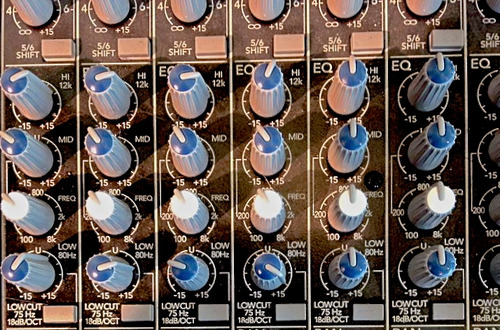
Above: Here’s my set-up for today’s EyeOn Portsmouth. Lots of EQ twiddling but we eventually got there.
A great experience today, I’ve enjoyed adding some real production value to the sound on a show!
Soundies- this is a great read on EQ and its capabilities. It’s quite music production based, but some of this can definitely be used in television. http://www.soundonsound.com/sos/dec08/articles/eq.htm
0 notes
Text
Freelancing for a staff-led Eye On Portsmouth.

Above: Sorting through AutoCue for today's Eye On Portsmouth.
Roles: AutoCue Operator and Sound Assistant
So now all student shows have beencompleted for the year, we still have space to fill for our regular Fridaynoon slot, as we still go live on the Portsmouth Big Screen, around theUniversity and online. Wanting to carry on gaining skills, I offered my services as an AutoCue operator and a Sound Assistant for a staff led Eye On Portsmouth. Although a relatively simple task, I’d never been an AutoCue operator before throughout my career in television to date. I was quite nervous as I was more used to being the one reading an AutoCue rather than the one in control of it.
We use a system called QStart to house the AutoCue script in the Eldon Broadcast hub. It’s really easy to set up as long as your file extensions are right (.docx .doc etc). All I needed to do was to make sure the latest script was on the system, import it and make sure the text was colored in white rather than black so the presenters could see it on the cameras.

Above: Although easy to forget (and I almost did!), I needed to make sure the AutoCue screen on the cameras was turned on via the little silver button- so small but so essential!
Operating the system was a little difficult at first because I wasn’t used to the sensitivity of the AutoCue dial, which controls the speed of the words shown on the camera. I accidently went too fast on it for the presenters, but after some practice I got used to operating it. I enjoyed the challenges of keeping in time with the presenters’ reading pace and when to start the autocue up again after interviews and VTs.
Once I got used to the operation of the AutoCue, I doubled up as a Sound Assistant. I did this because there were lots of guests on the show who were coming in and out, so the Sound Operator had his work cut out “unmicing” the finished guests “micing up” the new guests. This was done during the VTs so I stepped in to make sure the sound levels were appropriate because the Sound Operator had to vacate the sound desk.
Overall, it was a good experience to gain skills in running the AutoCue Operation system and I would happily help out on other shows again.
1 note
·
View note
Text
BSc (Hons) Television and Broadcasting class of 2015!
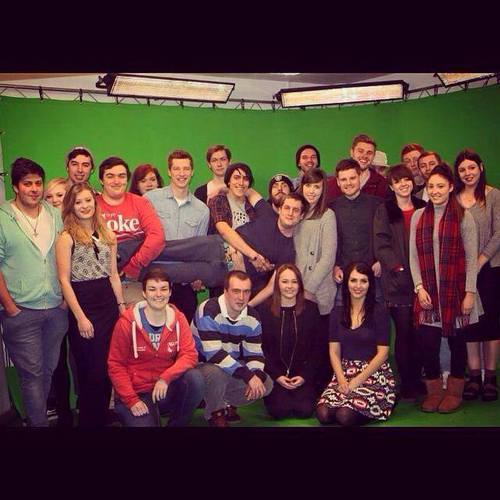
One for the archives, this. BSc Television &Broadcasting class of 2015!
#University of Portsmouth#BSc (Hons) Television and Broadcasting#Television and Broadcasting BSc (Hons)#TV Production#Chroma Key#TV Studio#University
0 notes
Text
Further Research: Sound Operation in a live environment
My interest insound operating really is growing, so I took a look at how it works on The Graham Norton Show. Really interesting to see what Graham Stuart's saying here and finding out about the inner workings of the show.
Executive producer Graham Stuart, who works on the Graham Norton show, recommends that everybody on set should be aware of how sound works in a studio environment. This is essential for a sound operator because it makes the job easier. In future, I plan to use more directorial skills with sound alongside the director to build a better experience in the studio, rather than controlling the sound by myself. This would include discussing things like audiences clapping, and audience participation.
He also discusses setting up a range of microphones for studio production, calling it "extremely complex", and creating a balance between how an audience reacts is "critical" to the success of a show. In my experiences so far, I have worked with much smaller audiences of around 15-30, using a single boom microphone in the process but remain appreciative of capturing an audience's reaction to content. In hindsight, I would have suggested this to the Director, but as the Eldon Hub television studio is open facing rather than closed off, it is more challenging to create better audio as there are often loud sounds coming from the cafe behind it.
Graham's made some really interesting points, here's the full link:
http://www.bbc.co.uk/academy/production/article/art20130702112135340
#Sound Operator#the graham norton show#BBC#TV Production#BBC College Of Production#University of Portsmouth#BSc (Hons) Television and Broadcasting
0 notes
Text
Sound Operating for Team Red's final show: Eye On Portsmouth.

Above: The official graphic for Eye On Portsmouth the third and final show produced by Team Red for CCITV.
Role: Sound Operator
Having become more confident in studio sound operation throughout the course of the year,this was a role I was keen to take on. I was aware that this was the last showof the academic year and the group were planning to make this a memorable one.I expected a challenge and this was the case, as multiple channels of sound were used in the live broadcast- more than I had used previously. I felt this was a good thing though as it meant I would improve my sound knowledge, whilst also gaining the skill of working under extreme pressure.
As stated, this was the last show we were to produce as a collective on the CCI Channel for the Television Broadcast unit. Team Red’s final show was Eye On Portsmouth . To give some background, Eye On Portsmouth is very much a community based show. It looks to broadcast a host of really interesting events going on in Portsmouth through live interviews and features. On a personal note, this was a hugely enjoyable show to work on as I met so many great people doing great things for the community and it was great to be given the opportunity to get their stories out on CCITV.
Developing the show in its early stages was a creative cauldron. Lots of ideas were being mixed together and early minutes threw up a host of ideas. These meetings were well lead by the Producer and I contributed ideas. These early ideas included ones, which did not come to fruition for the final show. One of these ideas included a feature piece with Los Dave, an artist based in Southsea. However, after trying methods of contacting him, it was not possible to set a filming date.
As a result, I suggested to the Producer a man called Ian Hendy. He’s a World Champion Natural Bodybuilder who also lectures in Marine Biology here at the University of Portsmouth. This was an idea thrown our way by the University’s press office for another unit called “TV Transmission”- a news programme for the University of Portsmouth. However, it was agreed in an earlier production meeting that it would be better to shoot this as a magazine-style feature as it didn’t fit into a news based show. To shoot this piece, the Producer organised a shoot with Ian in his lecturing quarters at the University. Here, he was interviewed about his lecturing, being a marine biologist and how he balances this with owning a gym in Southsea and regular training.
For the shoot I worked as the sound operator, using the Sony UTX-B2 transmitter microphone. I used the microphone because it was a small, portable device, which could plug directly into the Sony PMW-EX3 camera, a camera I’ve used throughout the year. As a precaution, I also made sure I had a second channel of sound being recorded in case the microphone breaks, meaning that I helped to make sure a reshoot wasn’t necessary. I chose a boom microphone to record the additional sound going into the second channel. During the shoot there were problems faced, as an automatic fan could not be turned off, which threatened the sound quality from the shoot but I resolved this issue by making sure the room wasn’t overcrowded, which meant the fan wouldn’t turn on. Upon reflection, I feel it may have been worth doing a location assessment beforehand so this problem could have been avoided.
Rehearsals
The bulk of my work as the Sound Operator for the show came during the rehearsals and on the day of the show. I used a total of 8 channels of sound for the broadcast through the The Mackie 1604 VLZ3 soundboard in the studio. Channels 1-4 consisted of the Sony UTX-B2 wireless tie microphones. Channels 5 & 6 were the Sennheiser eW100G3 handheld microphones, channel 7 was a beyerdynamic MCE86 ii, Channel 8 an AKG perception 150 and I reserved channel 9 as a spare channel should technical problems arise.
Below explains how I used these microphones- there was a lot of choice, and narrowing it down took a while!
Channels 1-4- Sony UTX-B2 wireless tie microphones.

Above: The wireless receivers for the Sony UTX-B2 microphones connected to the soundboard. These receivers are operated by rechargeable AA batteries and plugged into the back of the Mackie soundboard via a 3-pin male XLR end. In addition, the transmitters were also operated by 2x rechargeable AA batteries. I decided to give these microphones to the guests and presenters because these gave a direct pick-up of their voices. I felt that these would be the best because if I used a handheld microphone I risked picking up excess noise.
Channels 5-6- Sennheiser EQ 100 G3 handheld microphones.

Above: Setting up the handheld microphones. Each microphone uses an EM100 True Diversity Receiver to receive the sound. The receivers each have 2 antennai for wireless range extension and I plugged these in because it would guarantee signal strength. The receivers use mains electricity for power, but they were also plugged in via a 3-pin XLR to the soundboard. The handheld microphones, like wireless tie microphones are powered via 2x rechargeable AA batteries. I chose these because I wanted to be able to pick up sound during the dogs feature of the show. One of these handheld microphones would also later double-up as a vocal microphone for the musical performance at the end of the show because they have a close-range pick-up and are used during musical performances on a variety of television shows.
Channel 7- Beyerdynamic MCE86 ii shotgun microphone.

Above: Setting up Beyerdynamic MCE86 ii. This is a shotgun microphone suitable for picking up sound from the audience in a question/answer situation, which was a feature the group planned and the Producer organised. Again, this plugged straight into the soundboard via the XLR ports at the back of the soundboard. In order for this microphone to be used efficiently, the Producer Dom Hall asked me to recruit a boom microphone operator for this part of the show, as this meant I could concentrate on operating the channels on the soundboard. I used this microphone because I didn’t know which audience members were going to be asking questions at that point in the show.
Channel 8- the AKG perception 150 microphone.
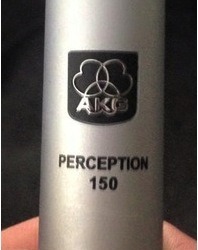
Above: the AKG Perception 150 microphone. This is a microphone I had not used previously, but after researching into it, I decided that this would be a good quality microphone to use for musical performances because of its pick-up range and its suitability for instrument recording. During the rehearsal, our musician Euan, who was playing out the show, was sound checked with the aforementioned Sennheiser microphone and the Perception 150 their quality and levels. I sound checked Euan because I needed to make sure I was prepared for the upcoming live show. Again, this microphone used a 3-pin XLR cable to plug into the Mackie sound desk, and power came via AA batteries. I was really impressed with the clarity and clearness of the sound it was able to record.

Above: the Shure SM58 vocal microphone.
Due to the amount of microphones I had and the amount of guests planned for the show, it was important to have a reliable contingency microphone should any technical difficulties or breakages happen during the show. Alternatively, I had this as an option for a vocal microphone for the live performance. This is a dynamic microphone which has in-built pop filters, which again improved the quality of sound.
Day of Broadcast:
The day of broadcast contained successes and technical difficulties, but it was one of arguably the most technologically impressive achievements at CCITV this year. I had high hopes heading into the show and the atmosphere was good amongst the crew when we arrived at 9am to prepare for the live broadcast at noon. We felt ready for our final broadcast of the Television Broadcasting unit.
Before long, I was wired up into the sound desk and discussions took place about achieving the best sound quality in particular areas of the show. As a sound operator, capturing the sound of audience participation was high on my agenda, and I spoke to the Director about picking up audience sounds such as clapping and questioning and we both agreed this was a key sector of the show. This was a success, and I instructed the boom operator I recruited to direct the microphone to the audience when the Director requested. I also made sure I used long XLR cable as it was important to make sure there was enough pull to reach audience members if they were far away.
I faced some technical problems during the broadcast, whereby the reliability of the handheld microphone (Sennheiser EM100’s) was questionable. When the microphones were live, there was an odd tapping sound coming from one of them, meaning that I needed to address the situation promptly.
One of the difficulties faced, was that the talent was not in the habit of keeping these microphones close enough within the pick-up range during interviews, so their voices weren’t picked up. I could not work out whether the tapping sound was coming from a presenter, so as a precaution I made sure the sound levels on both tie microphones were loud enough in case one of the handhelds stopped working.
Aside from this, the show was largely a success- it was entertaining and had some cool features, making it a good way to end the year. I’m confident in working with sound, and I look forward to developing my skills in using equipment. My knowledge of sound has enabled me to work closely with Directors and production crew and has enabled me to become a crucial part in building better studio shows. I’m now planning to develop my knowledge of EQ levels and sound panning when working on the remaining shows in the year.
Here's the link for the show!
https://www.youtube.com/watch?v=ExHv8SbuUCw
0 notes
Text
Freelancing for Team Blue's World On A Plate Show.
Role: Camera Operator

Above: Discussing shots through TalkBack with the Director.
On the 22/01/2015 and 23/01/2015 I stepped in as a Camera Operator for Team Yellow’s World On A Plate show. As a Camera Operator, working on this show was the most challenging to date in comparison to previous shows. This was down to organizational issues within the production group. Despite having good ideas, a lack of full rehearsal and communication between both studios made the show challenging to work on. To overcome this, I tried to work as closely with the Director as I could but technical and organizational issues meant my time to discuss shots and receive instructions were limited. This meant I had to work to the best of my ability to ensure that I had the correct focused shot at all times, but making sure I was also listening to the Director when they instructed me to suddenly change shot at short notice.
Another challenging factor to work with for this show was receiving verbal instructions rather than a camera script. I found this difficult to adapt to at first because normally I am given a script, but eventually I got the hang of working in this style and built upon skills I learned previously. Skills I learned during this show were focusing the camera quickly whilst conversing with the Director.
As the show went live, the tally light on my camera stopped working so I could not tell when the vision mixer was cutting to my camera. I was really worried about this, as I couldn’t tell when my camera was live, so I took it upon myself to keep calm and make sure I have close communication with the Director, to make the team was also aware of this situation too as soon as it happened.
The show also had lots of camera movement and involved lots of refocusing on guests or food for the “chilli challenge” part of the show. This was a high-pressure environment that I had not necessarily been exposed to on other shows, but I felt I gained a new skill, as most of the camera work was successful. This was a real challenge, as I had no rehearsal, so I had to pick up skills quickly.
Overall, the show was a success as the ideas and creativity carried it through, but the quality could have been improved if communication was better. I feel I developed some good skills here and with more camera experience I will continue improve in my speed of operating the cameras.

Above: One of the shots a guest on the show trying a chilli. This shot was of good quality as I had enough time to get the focus right. On a personal note I'm delighted I caught this shot- look at the contestant's face! TV gold!

Above: Unfortunately this shot is out of focus. The Director cut to it but I was unaware of this due to the breakage of the tally light. Still a brilliant moment from the show though!
#CCITV#World On A Plate#Freelance#Camera Operator#TV Gold#Funny#TV Production#TV Studio#university of portsmouth
0 notes
Text
#TVFutures Article!

Recently I wrote a piece for Kit Plus (formerly known as TV Bay) magazine where I discuss the social media geekery I'm combining with my work for CCITV and my dissertation. The higher quality picture is available upon request.
#TV Bay Magazine#Kit Plus Magazine#TV Production#Social Media#Social Media Manager#Article#Brand Management#Marketing
0 notes
Text
Freelancing for Team Green's CCi Live show.
Role: Floor Manager
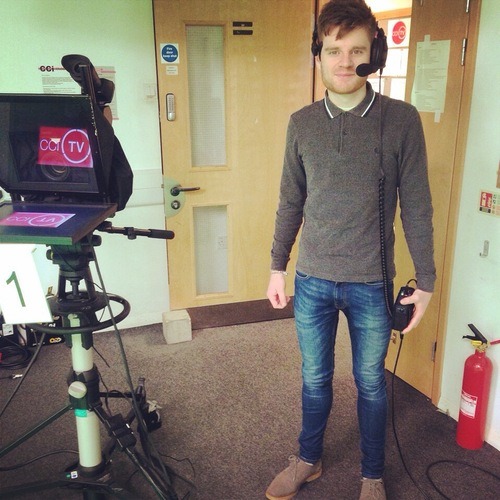
Above: Working as the Floor Manager in the CCi Studio for Team Green.
On both the15/01/2015 and 16/01/2015 I worked as a floor manager for Team Green,whom asked me to step in as a Floor Manager for their CCi Live show. During my role, I worked closely with the production team looked after a new presenter for the channel.
This was the first time I worked as a Floor Manager, and found the experience varied and challenging. Initial difficulties included distinguishing when the Director was speaking to me but after a while this was something I got used to by keeping a close ear on what was happening in the gallery whilst I was in the CCi Studio. Another skill I learned was keeping the presenter aware of what was going on at all times and making him more relaxed ahead of the show.
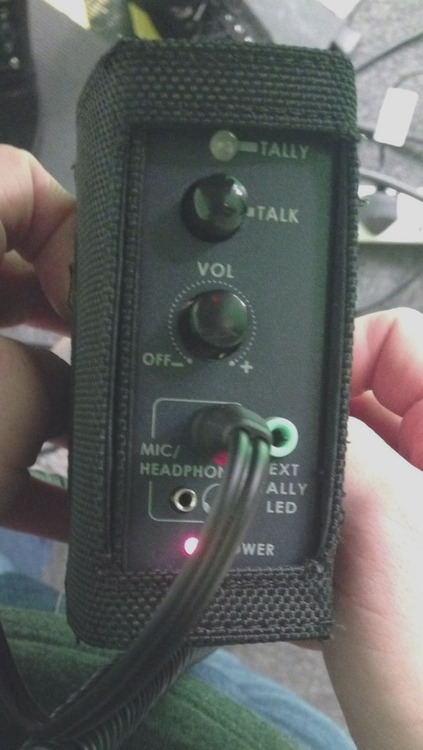
Above: The TalkBack system I used. This connected to mains electricity via a 5-pin XLR cable. To talk to my Director- who was the only other member linked to the system- I just pressed the “Talk” button. I also used a headpiece, which connected to via a 3.5mm jack. The TalkBack system fitted to the director’s box via a 3-pin XLR cable. I enjoyed using this and found it easy to use and set-up.

Above: The MC1 Headphones that come with the Talkback system. I find closed-cup headphones are probably better over a long period of time- they're more comfy!
This was a good experience and I built better communication skills by learning hand signals that Floor Managers traditionally use alongside, talking clearly and efficiently with my Director.
0 notes
Text
Freelancing for Team Blue's Eye On Portsmouth show.
Role: Camera Operator
On both 20/11/14and 21/11/14 I worked as a Camera Operator for Team Blue who asked me to work on their show. I had undertaken camera work previously, but this time I wanted to learn more about setting up the studio prior to broadcast. Alongside this, I learnt about linking up the TalkBack system to the Director’s box, which connected via an XLR cable, whilst the earpiece connected to the TalkBack box via a 6mm headphone jack. This allowed me to keep communication with the Director throughout.

Above: Working as a Camera Operator for Team Blue's show.
The camera I used was a Canon XLH1. This is a high-definition camera, which shoots at 1080i. The camera also has selectable frame rates but for UK broadcast transmission we use 25fps. It’s a good quality, affordable camera for broadcast. It excited me because it has a good range of settings giving lots of production options. It sends a good signal through the SDI slot and is really easy to set up, even for a first-time user of this camera like myself. However, one thing I found difficult about working with this camera was that it had a small screen to reference the quality of my shot. I’m not a big fan of using viewfinders, as my preferred technique is using the camera screen to reference my shot. I kept close communication with the Director through talkback on the quality of my shots throughout, as the size of the screen was too small to make sure focusing was good enough.
Specifically, my role was to converse with the Director and make sure my framing was appropriate for the studio content. I was required to frame on a static two-shot for one interview, then for the second half of the show I was responsible for framing the guest and switching between a close-up and two-shot. I learned how to move the cameras safely, assuring that no cables were caught up in when moving to different areas of the studio and making sure shots were focused. Multitasking here was an important skill but also challenging because I balanced many tasks at once. This was successful as I managed to move the camera safely and keep shots focused. I would be a Camera Operator again because I would like to improve my skills, and keen to experience different types of shots for different shows.
0 notes
Text
Freelancing for Team Green's CCI Live Show
Role: TriCaster Operator
On both 13/11/2014 and 14/11/2014, I worked as a TriCaster Operator for another production group, who asked me to step in for their show, which was to be broadcasted on 14th November. Working with the TriCaster system is a job I had not yet experienced, but I was worried but excited as I had never worked on the visual side of mixing a show before. Therefore, I wanted to pick up some new live production skills.
The NewTek TriCaster 860 multi-standard vision mixer is a brilliant product. It brings that edge to a live programme but really simplifies production too. For the show, I ingested footage ready for playout, created straps and stings. Specifically, my role within the show was to create name straps and VTs matched the running order, so they could be cued for the Vision Mixer to play when the show was broadcast. It was also my responsibility to make sure that the show was recorded for archive and on demand purposes and the titles were mixed correctly into the Green Screen for the start of the show. I felt I dealt with this competently.

Above: Ingesting footage through the TriCaster’s ingesting agent. I saved the footage into a date-based folder, which assured all files were organised in the right order, at the right date, for the right show.
Here, I learned how to organise media for live broadcasts- from VT features to name straps and prepare and archive recordings for YouTube services, which was a skill I did not have previously. Working as a Tri-Caster operator was a successful experience, as I did not make any errors when the show went live. In addition, the show was a success and I gained a new skill in Tri-Caster operating having not used it before.
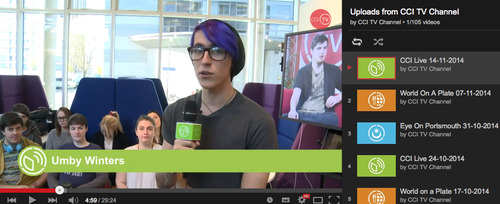
Above: An example of one of the straps I prepared for the show through the TriCaster system. These were title-safe and used the branding for CCI Live, which can be seen on the left.
0 notes
Text
Further Research Into Directing: John Smith's (The Weakest Link) Tips on Directing
I’ve been building my skills in Directing for a while now, and have found it a really challenging job- particularly as afirst time Director for World On A Plate.
John Smith, a multi-camera director at the BBC is someone who I think does a terrific job at directing multi-camera shows and I really admire his work on The Weakest Link. We both seem to follow the same mantra- preparation is key. I speak nothing but high words of his talents, as directing 5 cameras are a mammoth task.
When times got tough on World On A Plate, which they did (I’ll be honest here), it was a real test of patience. However, I dealt with this by trying to be as enthusiastic as I could, and John seems to use the same techniques by trying to keep the production team in good spirits.
He also discusses the importance of alternative ways of thinking about what can be achieved in a show. He calls this the “lateral thought” or “a sideways look. Combined with an alternate way of thinking, and John’s idea that “at least 75% of work is done before you sit in front of the monitors”, his advice I’ve mentioned here has been really helpful for me because watching a seasoned professional has helped me gain skills I didn’t have before.
Here’s the full video- I’ve found it so handy!
http://www.bbc.co.uk/academy/production/article/art20130702112135647
0 notes
Text
From Concept to Broadcast: Directing Team Red's Second Show, World On A Plate.

Above: The graphic for World On A Plate, the second showcreated by our production group this year for CCITV.
Role: Director
Although it was eventually a success when we went live, directing World On A Plate was a challenging process, packed full of various issues from communication difficulties to production issues.
To give some background, World On A Plate is a studio-based magazine show that aims to give backgrounds about various cultures that shape the world around us. These are often wide ranging and the aim is to create a stronger identity of a culture to those who may not have experienced it, as well as making international students feel at home as CCITV welcomes their culture. However, it can be a really difficult format to realise and is a true challenge.
After calling a group meeting after the group’s previous show, CCI Live, Team Red reflected on its performance and as the course ethos is to support multi-skilling and the production team members were all very willing to change roles for this programme, to help develop new skills. I wanted to work as a Director for the show as I hadn’t done this before and I was excited at the chance to develop a vision for World On A Plate. I felt confident, as I had built a good relationship with the rest of the team and felt like I was a strong communicator.
During early meetings, the group realised that the food features were lacking in the show, and we wanted to bring cultured food to broadcast. We did this to help address the logline of the show and give international students a reminder of home and an appreciation the food of their culture. Below is the show’s logline:
“A special programme produced to welcome and feature all University of Portsmouth students from around the world. The show focuses on culture, and helps to acclimatise anybody new to the U.K. Oh, and it’s about great food too! “
I also wanted to make the show exciting to watch as a live broadcast, so I wanted to develop live cooking segment to take place within the Eldon Broadcast Hub. The Eldon Broadcast hub is a versatile area that has hosted a selection of interviews and performances on CCITV. Secondly, I wanted the show to feel interactive and fun in front of the live audiences that had been gathering weekly for the other shows produced on the channel. I wanted this as it made for a better audience experience- they could watch the dishes being cooked and keep up with the additional on location features for the show.
With regards to filming the VTs, budgeting for food costs was a difficult process because the money for the food came from our own pockets, so I made sure I kept financial tabs on who had paid for what.
For the show, I directed 3 VTs, one of which was completely cut and re-shot, a re-shoot which I was unfortunately put in a position where I also had to present, and the third of which took a different direction to the original planned narrative. Here, I learnt how to adapt to an unexpected turn in production and also learnt to work closely with my Editor. These are all explained in more detail below.
Gully Goes Shopping (VT)
For this shoot, I decided upon using a Sony PMW EX3 camera. I have experience working with this camera and really enjoy working with it because it’s a diverse piece of equipment. This worked well for my camera operator because it allowed him to use pull and focus techniques when getting close-ups of foreign foods, which was shot at the Rabias International Supermarket in Fratton, Portsmouth.
The Producer wanted this VT in tandem as a narrative for the show. I worked with the Producer to create a story with the presenter purchasing a selection of international ingredients that would be used down in the Eldon Broadcast Hub on the live show. To record sound we used a MixPre Compact Field Mixer and omnidirectional microphone alongside a wireless tie microphone that was also attached to the presenter. This is where the problems occurred. The problem was the sound within the supermarket we filmed in. The freezers had a low humming sound. I realised this was a problem, so I asked whether it could be turned off but this was not possible. Upon ingesting, I realised the feature needed reshooting because of the aforementioned sound issues. To overcome this, I requested to the Producer that the VT needed to be voiced over instead to be acceptable for broadcast. Here, I learned that my communication skills were important between the group members as the VT was changing from its original plan.
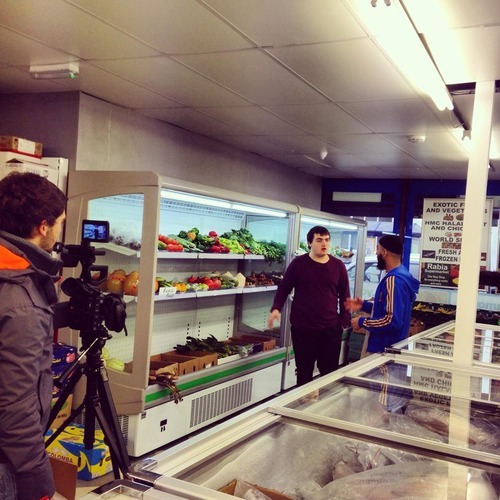
Above: The talent being filmed by the cameraperson at Rabia supermarket in Fratton for the shopping piece. The problems were the freezers, which produced a low humming sound. I then directed the Editor to add a voice-over instead as stated previously.
Once the voice-over correction work had been completed and a new music piece from audio network added, the video was exported with the 1920x1080p, MP4 format, 48Khz, 16-bit stereo settings and uploaded onto the NewTek TriCaster in the CCI Studio Gallery once staff had signed it off.
International Cooking VT
Within the making of the show, I found this VT to be the most challenging. As Director, I wanted the VT to have a personal meaning and so I got an English speaking international student to cook a dish of value to them. Alongside the cooking, I planned to have the presenter and student within the same shot whilst the student tells their story so it would feel natural and carry the piece. There were some problems faced with the booking of a kitchen for this VT. The Producer attempted booking a college kitchen to film the VT but the venue’s poor communication meant this had to be cancelled. In addition, the Producer was in charge of booking a presenter. However, I took this situation upon myself and sourced another location, but unfortunately, the desired presenter was unavailable and the Producer was unable to book another. I did not want to waste my team’s time so decided that I would have to fill in. This was a skill I learnt as, Directing and presenting the same feature was an impossible task and as our cook spoke minimal English it was a challenge to work with. As a Director, I decided this was difficult to deal with, as our Producer was not present despite having booked the guest. I think it would have been better to include the Producer on this shoot as it would have eased our guest. Because of these reasons, I decided that it would be unfair to the guest who could speak minimal English to produce and explain a dish, and for me to be a presenter as well as director. So I made a decision that we should re film with a new guest, and have a presenter because it was a tough challenge to direct everyone whilst concentrating on what I needed to say to camera. Below are pictures of the initial set-up we had for the first shoot of the International cooking VT, which I eventually scrapped, after mutually agreeing with the Producer.
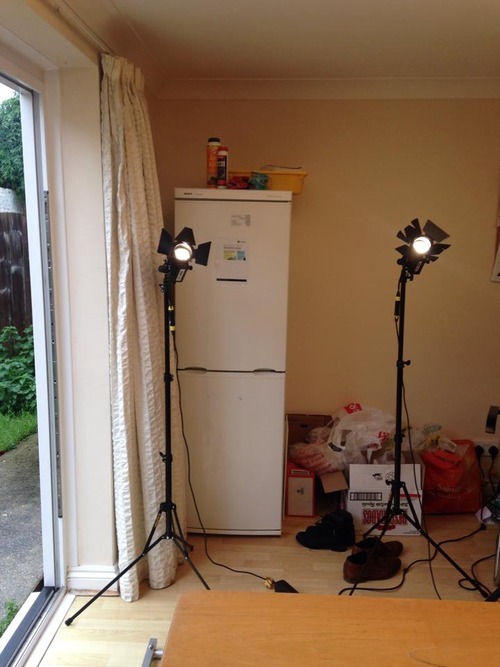
Above: I told the lighting operator to use a three-point lighting set-up. However, even with the faders on their lowest setting, the lighting was too powerful in the kitchen when combined with the natural light from outside. To overcome this and get the best lighting balance, I pointed the dedo lighting kit up to the ceiling. I did this because the light would still reflect down from the ceiling and give a softer fill on our subjects. This took a while to set up but worked successfully and as Director I was happy for filming to commence.
Re-Shooting.
As Director I knew the VT shot previously would not be acceptable for broadcast. I explained this to my Producer and my disappointment that things did not turn out as planned. My solution to the problem was to re-film the piece in its entirety with a new guest. I also strongly suggested to Producer to book a presenter, as Directing and Presenting the same piece simply cannot work on a professional level. However, the Producer failed to book a presenter so I solved the situation and save production time by stepping in to present again. This meant I had to miss a meeting elsewhere, but I recognised it would be unprofessional to leave the set.

Above: Romeo, our guest for the international cooking VT. I wanted a profile of Romeo because the audience could build a connection with him by finding out about his love for cooking.
Having not made television before, I explained to Romeo about the production process and achieving continuity to make him feel more comfortable with myself and the production crew. Examples of capturing continuity are shown below. This was all done by the Sony PMW-EX3 camera.

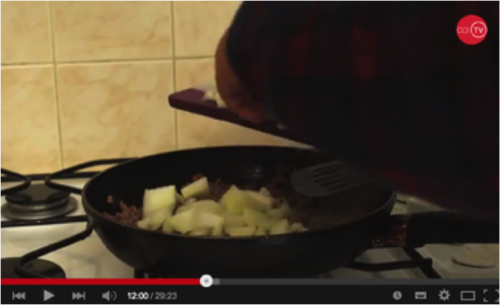
Above: Continuity from the edit.
Broadcast and Rehearsals.
Once the edits were completed, exported and signed off, I made the decision that the group were ready to rehearse. At this point, the group were running behind on scripting, so I took this on myself by adding to the script prior to the rehearsal. The lack of input from the group was disappointing but I was still hungry to direct the show as well as I could.

Above: I worked with the Producer on November 5th to refine script qualities.
Rehearsing the show was challenging. Our booked guests had pulled out from the show due to timetable clashes. To overcome this I worked closely with the Producer to find some exciting new guests. However, some of the group acted in an unprofessional manner after finding this out and I solved this by organising a production meeting to discuss the events that were occurring. The outcome of the meeting was successful as it gave clarity to every group member on the content of the show. I felt this was a new skill gained for me as I turned something bad into something good.
Another challenge I found with the show was directing two studios. I was based in the CCI Studio gallery, but sometimes required to visit the Eldon Broadcast Hub as communicating issues was longwinded. For me, this was a stressful situation, but I resolved it by staying calm at all times and sorting any problems out promptly.
I spent much time directing shots with the TriCaster Operator, directing the presenters, camera crew, working with the guests and discussing technical issues. I learned good directorial skills here but also found it challenging to multitask because as Director I found myself in demand from production crew. I felt I dealt with the demands well by remaining calm and dealing with each situation as well as possible.
Throughout the show, I learnt how to improve my vision of a show from concept to broadcast from a Director’s perspective. I feel I worked to my strengths such as working closely with different personalities and realising ideas. I have improved with regards making contingencies whether as a Director or in a team.

Above: The production crew working on the set design I co-created with the Producer and Floor Manager, whom I asked to secure props.

Above (from left to right): Our replacement guest Rachael, who filled in at the last minute for the show. Gully, our presenter and James, Rachael’s competitor.
I learned a lot from this show as a Director, and I would give 3 tips to new Directors if you find yourself in a difficult situation:
1- Stay calm. It seems easy to say sitting here whilst typing a blog about it in hindsight, but staying calm does you huge favours. You are all in this together and there’s a host of creative minds at your disposal. You will, somehow or other, find a way to surpass issues.
2- Build professional relationships with your crew. It makes it so much easier if you work together rather than against each other. If problems arise, they can always be talked about in a calm way if you create an environment where people feel like they CAN approach you if there are problems.
3- Never give up. You will have problems- guests may pull out of your show, features may go wrong and it can be difficult. But if you persist, by staying calm and building a relationship with your production team, you will find that you will relentlessly carry on in pursuit of directing a brilliant show.
So here it is, World On A Plate for CCITV!
World On A Plate- 07/11/2014
http://youtu.be/mIRVALiL7nM?list=UUbUcTkAVUNdPZ7kSZbu_wlg
0 notes
Text
Thrown in at the deep end- welcome to third year!
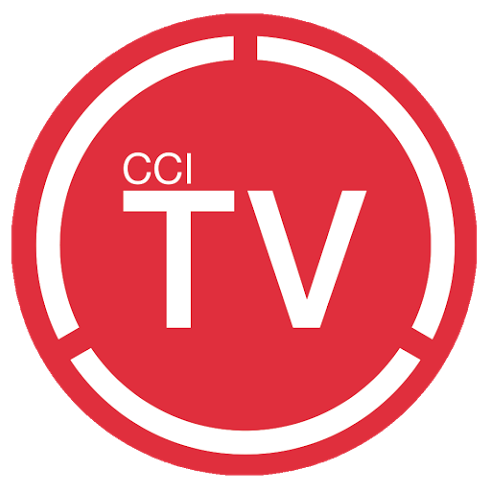
Above: CCITV Logo.
Priorto the beginning of the academic year, production groups were allocated viae-mail. These groups were the production groups that I would be working with throughout the academic year to produce shows for CCITV- the University of Portsmouth’s official television channel, as part of the “Television Broadcasting” unit as a final year student at the University of Portsmouth. Within the year group, there are 6 groups overall- I am part of Team Red.
There were five other colours allocated for the remaining teams. These were: green, yellow, orange, blue and black. Team Red- my team- is a team of 7 final year Television and Broadcasting students. Throughout the course of the year, we are going to produce three programmes for the Creative and Cultural Industries TV or CCITV for short. These three programmes are CCI Live, World On A Plate, and Eye On Portsmouth. Every Friday at noon, the shows go live on Portsmouth’s Big Screen, YouTube, the CCI Channel website and around the University. All shows are studio-based magazine shows containing a range of features and interviews relating to the show’s brief. The first show Team Red were in line to produce was CCI Live, which would also be the first show of the academic year.
To give some background- CCI Live is a show is a magazine TV programme featuring events and selected pieces of work that students have produced at the University of Portsmouth. The show is 30 minutes long and is broadcast as an aim to showcase work.

Above: The logo for CCI Live.
Role: 2nd Unit Sound Operator (Eldon Broadcast Hub)
The group were broadly briefed on the show’s content before sorting distributing production roles. The aim of the first CCI Live of the year was to welcome back returning students and introduce new students and staff to both the University and faculty.
Within the first group meeting, we reflected upon the CCI channel’s achievements so far. Focusing on CCI’s 24-hour live broadcast achievement was something we felt was important as it would brighten up the audience’s mood about the upcoming academic year and it would also work well as a light-hearted introduction for the show. Roles for the broadcast were also assigned with my role working as the 2nd unit Sound Operator in Eldon’s new Broadcast Hub studio. I wanted to do this because I was very keen to work out how to use the soundboard and learn about different microphones and their features.
However, throughout the production process of the show, my roles were greatly varied. I presented the VT for the CCI Faculty welcome event, as we caught up with new students ahead of the new academic year, worked as a co-presenter when introducing the managers of the CCI channel as well as assistant producing. This bought the show together because I completed risk assessments, call sheets and studio scripting. Upon reflection, lack of role structure within the group during production was a little detrimental to the show because it made making the show a more challenging task. However, if this was to happen again, I would make sure all crews had assigned roles so each member knew what they had to do and could then branch out and help others if required.
When it came to broadcast, I was in charge on controlling the sound levels from a Mackie 1604 VLZ3, something I hadn’t done before. I was worried but overcome this by making sure I relaxed and got information on the product I was using. For the show, the director decided upon using 5 channels of sound. Initially I was concerned this would over complicate the show, but realised this was the best decision because I needed a back-up microphone in case something went wrong. There were 2 tie microphones on channels 1-2, two boom microphones to pickup audience clapping and a back-up tie microphone on the fifth sound channel. All channels of sound were manually connected at the top the sound desk via a 3-pin XLR cable. I hadn’t used any of these microphones before but after researching into what we had available I felt confident I had made the right equipment choices.

Above: A full shot of the Mackie 1604-VLZ3 sound desk.
The Mackie 1604 VLZ3: Further information and how it was used in broadcast.
I’m now quite a fan of the Mackie 1604-VLZ73. It’s a real heavy-duty piece of kit and the 16 channels of sound open up so many possibilities from a production perspective. The team and I devised a good sound arrangement for CCI Live, using the channels “Mic ” (for the presenter), “Mic 2” (for Catherine Harper, our interviewee) and finally “Atmos 1” and “Atmos 2” for the omnidirectional microphones that picked up sound from the audience- such as clapping. It is worth noting that I also listened to the instructions of the show’s Director, when they wanted the volume to be increased. The sound received from these microphones was adjusted by myself to -19db. This was because sound was slightly condensed as the shows are transmitted through a NewTek TriCaster, which meant sound volume was slightly compromised. This gave some flexbility with volume headroom.
I decided to use wireless radio microphones because these are a smart, minimalist look option for studio production. In my experience, I have found that Sony is generally excellent in many technology fields, including the broadcast tie microphone market. The all-round quality of these tie microphones is excellent. They’re quite rugged and reliable for use in a studio environment. These radio microphones came with the transmitter and the receiver. I made the decision to make both the presenter and the interviewer wear the same microphones in a sit-down interview at the end of the show, because I feel they look professional in an interview situation. I found that they were quite awkward when setting them up on presenters and guests because the microphone itself has a clip, so I had to learn how to clip these on properly. This was a challenge to learn but I eventually got the hang of clipping the equipment onto clothing properly.

Above: The Sony UTX-B2 transmitter microphone.
Another reason I used these microphones was because of the quality of sound it picked up. Also, I felt these were the most suited to the environment the broadcast took place in, as they had a smaller pick-up range than the alternate microphone I considered which was the Sennheiser eW100G3 (pictured below.) The Sony wireless tie microphones operated on AA batteries, so it was important that I assured that the batteries had plenty of power to last throughout the broadcast otherwise it would lead to difficulties if one of the microphones cut out during the show. They also had a 0-21db adjustment range, allowing the pick-up of a range of voices. It is also worth noting that this could be adjusted on the sound desk, but was unnecessary for the show because during rehearsals I made sure it was set up to what was needed. I used the operating frequency of 606MHz to 630MHz for both microphones, to make sure they mirrored what the receiver was set to; otherwise the receiver wouldn’t pick up the signal from the microphone.

Above: The Sennheiser eW100G3 Handheld microphone
This microphone is a wireless microphone that can also be operated by AA batteries, has a 42MHz bandwidth and is also omnidirectional. However, it has a larger pick-up range than the aforementioned Sony wireless tie microphones. As the second unit Sound Operator for the show, I deemed this an inappropriate microphone to use for the show because its larger pick-up range risked picking up the sounds of people talking in the background. Also, at the time of broadcast, there was an interactive art display which allowed passers-by to play African drum kits which were also picked up by the receiver.
Final Reflection:
Overall, the show was a relative success. The VTs ran well, as well did the content from the CCI Studio (the studio with the chroma key for industry heads who may be reading). However, the main problem with working as the Sound Operator for the Eldon Broadcast Hub was that I had not used the studio before. Problems included choosing a microphone as explained above, but also there was some feedback received from the speakers during the broadcast. Unfortunately, these were recorded into the broadcast. This happened because our presenter for the interview spoke quieter during broadcast than when she did in rehearsal. As a result of this, I was instructed to turn up the gain via the sound desk by the Director, in which I did. However, it caused distortion and I had to communicate back, warning them that this harmed the quality of the broadcast.
It is difficult to distinguish where my role could have improved here, as I did all I could with the equipment but did not have any communication with the presenter, so here I was unable to make her aware that she was not speaking loud enough. This message could not be laid on via the floor manager either due to the fact that it was difficult to communicate and would have distracted the presenter, who was making her debut for the channel. I feel that if I was offered the role of Sound Operator again, I would take it on because I would want to improve my skills on using a greater variety of microphones.
So here it is, the first CCI Live show of the 2014/15 academic year!
CCI Live- 26/09/2014
http://youtu.be/rTxQD9nfaXY?list=UUbUcTkAVUNdPZ7kSZbu_wlg
#CCITV#Final Year at University#CCI Live#TV Production#Quick Turnaround#Magazine Show#Eye On Portsmouth#World On A Plate#Sound Operation#Sound Op
0 notes